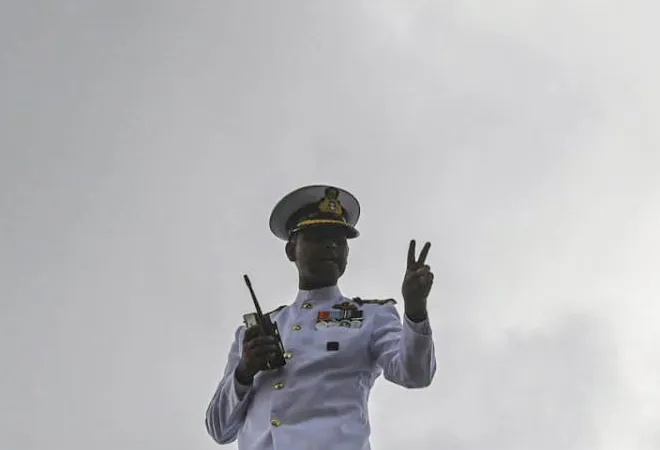
Alfred Thayer Mahan, the acclaimed naval historian, saw the sea as a “great highway” and a “wide common” over which commerce and military force flowed freely. The renowned American theorist described “sea power” as an indispensable instrument of state power, and “maritime access”—commercial, diplomatic, and military—as the critical element of maritime strategy.
Comprehensive access to vital sea spaces, he averred, had the potential to propel a nation to great power status.
As India marks its 77
th Independence Day, it is apt to reflect on the country’s growing maritime power, not only to assess the country's rising strategic prowess but also to examine if Indian maritime capabilities have been in line with the Mahanian precept of “access to the great commons”. India's dependence on the seas for trade and commerce necessitates the protection of the sea lines of communication. It is worth inquiring then if the Indian Navy (IN) has effective command of the seas, as Mahan has deemed it vital for success in a naval conflict. How has New Delhi’s Indo-Pacific strategy coped with rising traditional and non-traditional threats at sea?
India's dependence on the seas for trade and commerce necessitates the protection of the sea lines of communication.
New Delhi's biggest challenge in the maritime domain is undoubtedly China. Since 2008, when Beijing first sent its warships to the Gulf of Aden for anti-piracy duties,
China’s military presence in the eastern Indian Ocean has significantly expanded. Beijing has sought to exert influence over the Bay of Bengal states through investments and infrastructure development projects. Bangladesh, Myanmar, Sri Lanka, and Thailand have all benefited from China’s Belt and Road Initiative (BRI), as has Pakistan, China’s all-weather friend in South Asia. Some countries have even allowed Chinese-built commercial facilities on their territory to be used for quasi-military purposes.
To counter China, India has sought to build maritime muscle and increase its naval presence in the Indian Ocean. The IN has embarked on an ambitious plan to create a
175-ship force by 2035, setting milestones to push indigenisation and cast away the dependence on foreign suppliers. Forty one of the 43 ships under construction are being built in Indian shipyards, with proposals to build 49 more ships and submarines in the approval pipeline. In order for the IN to be
self-reliant by 2047, naval commanders are focused on futuristic capability development, devising plans to overcome complex security challenges in the maritime domain. A range of warfighting platforms and assets are being acquired to create a versatile and adaptable force, capable of action at many levels.
The IN has embarked on an ambitious plan to create a 175-ship force by 2035, setting milestones to push indigenisation and cast away the dependence on foreign suppliers.
Nonetheless, the pace of naval ship construction is struggling to keep pace with strategic needs. The IN's capital budget is small, with a pace of construction much slower than China's. Although India is building more warships than in the past, the
asymmetry with the People’s Liberation Army Navy (PLAN) is still stark. In contrast to China, which builds almost 14 warships a year, India constructs just four.
The
deficit in the undersea domain for India is particularly glaring. Even after the induction of five Scorpene (Kalvari) class submarines, the IN is eight boats short of the stipulated 24 scheduled for induction by 2030, in accordance with the Navy’s 2012–27 Maritime Capability Perspective Plan (MCPP). With the older Kilo and HDW/Shishumar class boats due for decommissioning, the IN has pinned its hopes on Project 75-I, which is yet to take off. A plan for the indigenous construction of
nuclear attack submarines is still on the drawing board.
On the upside, New Delhi has bolstered its maritime strategic posture through partnerships. India’s political leadership has made ‘
rules-based security’ a priority, with efforts to improve coordination with regional partners. The IN, which sees itself as a
first responder to crises in the Indian Ocean, has been at the forefront of cooperative endeavours with Bay of Bengal states, ASEAN countries, and Quad powers. A key objective is to improve interoperability with partner navies and build smaller partner capabilities. Shore-based radar chains, satellite systems, and an information fusion centre in Gurugram, Haryana, have helped regional navies and coastguards improve their response to crises.
India’s political leadership has made ‘rules-based security’ a priority, with efforts to improve coordination with regional partners.
Yet, challenges in the nontraditional realm persist. While situational awareness in the littorals has improved considerably, the IN finds itself stretched in the littorals. The problem, as many describe it, is a
lack of law enforcement capacity. Dealing with threats such as drug and contraband trafficking, armed robbery, human smuggling, and illegal migration requires constant vigilance in the commons. But many of India’s neighbours have limited naval and coast guard capabilities. The mission set in South Asia is rendered complex by the blurring of lines between conventional and irregular threats. If the IN has focused disproportionate energy and resources on littoral security, it is because naval planners have had few options.
To be sure, maritime power is more than a matter of policing the commons or accumulating and projecting military force in the littorals. Sea power is equally about creating prosperity for the people and meeting the needs of national development. Here, India’s
Maritime Vision 2030 merits mention. The 10-year blueprint for the maritime sector envisages the development of ports, shipping, and inland waterways. Since it was announced in February 2021, India’s ports and maritime logistics sector have shown significant growth. According to the recently released World Bank’s
Logistic Performance Index (LPI) Report 2023, India is at the 22
nd rank in global rankings in the “International Shipments” category (up from the 44
th position in 2014) and 38
th rank on the LPI score—a notable improvement by any measure. Not coincidentally, the
ocean-based economy was a subject of much interest and debate in G-20 discussions under India’s presidency this year.
Since it was announced in February 2021, India’s ports and maritime logistics sector have shown significant growth.
If port-driven industrialisation is a bright spot for New Delhi, maritime governance remains a problem area, particularly the vexing issue of illegal and excessive resource exploitation. In recent years, illegal fishing in the Indian Ocean littorals has grown exponentially. Extra-regional
distant water fishing fleets are mainly to blame, but the problems can also be attributed to lax regulatory implementation and faulty policies that encourage unsustainable fishing practices. With the marine habitat and biodiversity in rapid decline and climate change and extreme weather events on the rise, the IN and Indian Coast Guard are being increasingly called upon to police vulnerable sea spaces and deliver
humanitarian and disaster relief to coastal communities. This significantly reduces the operational bandwidth for distant seas operations.
India’s maritime theorists and practitioners are coming to grips with the reality that they are no longer in the era of Mahan, when military force and command of the seas were a sure route to great power status. Today's time is more complex, not only on account of globalisation and economic interdependence, but also because of growing non-traditional challenges and a shrinking appetite among maritime states for naval conflict (notwithstanding developments in the Black Sea and the South China Sea). Countering maritime threats today needs partnerships and collaborative synergy to sustain security initiatives in the littorals. Partnerships are exactly what India has its sights set on in the Indo-Pacific region.
Abhijit Singh is Head of the Maritime Policy Initiative at the Observer Research Foundation
The views expressed above belong to the author(s). ORF research and analyses now available on Telegram! Click here to access our curated content — blogs, longforms and interviews.



 Alfred Thayer Mahan, the acclaimed naval historian, saw the sea as a “great highway” and a “wide common” over which commerce and military force flowed freely. The renowned American theorist described “sea power” as an indispensable instrument of state power, and “maritime access”—commercial, diplomatic, and military—as the critical element of maritime strategy.
Alfred Thayer Mahan, the acclaimed naval historian, saw the sea as a “great highway” and a “wide common” over which commerce and military force flowed freely. The renowned American theorist described “sea power” as an indispensable instrument of state power, and “maritime access”—commercial, diplomatic, and military—as the critical element of maritime strategy.  PREV
PREV


